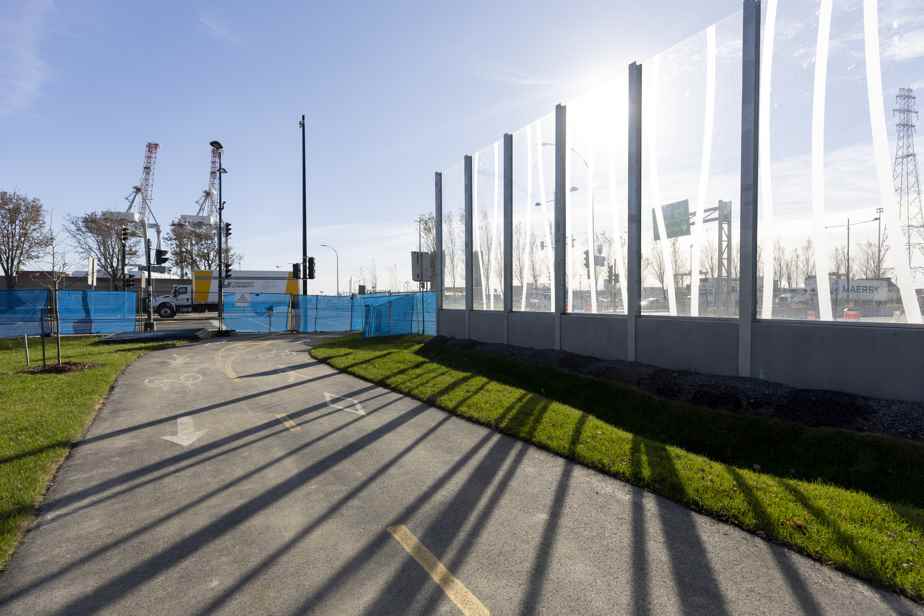It’s like an oasis of greenery hidden in the endless stream of trucks leaving the Port of Montreal to head for Highway 25. Mulch beds line the wide multipurpose path that crosses a landscaping full of bumps and reliefs between the rue Notre-Dame and rue Lecourt, in the former right-of-way of rue Curatteau. The transparent noise barriers drown out the roar of the trucks in the ambient noise of the sector, which remains high, but their presence protects against the direct assaults of the 80-something decibels of the trucks. It’s a nice discovery for the neighborhood, a great success for the Ministry of Transport and Sustainable Mobility of Quebec (MTMDQ). The asphalt is new, the ground is immaculately clean. And it’s… closed.
Posted at 5:00 a.m.
At the corner of Curatteau and Notre-Dame streets, heavy metal barriers prohibit passage, covered with tarpaulins to hide the area from view. Since the first time he was able to take a look at it several months ago, Daniel Chartier, a retired landscape architect and resident of the Mercier-Est district, often drives by just to see if we have finally opened.
He doesn’t know how long the development work has been completed, but he shows us a photo from last April. The multipurpose path is already asphalted and the marking has been done, but it is forbidden to pass because of the development work in progress on both sides. Months have passed. “Having managed park development projects for 37 years for the City of Montreal, I must say that the deadlines for construction sites are beyond belief. »

PHOTO MARCO CAMPANOZZI, THE PRESS
Closed entrance to the new bike path at the intersection of Notre-Dame and Curatteau streets
“At one point, he said, I thought we were waiting to make an official ribbon cutting for the election campaign. But no. »
Shortage of bollards?
At the Ministry of Transport and Sustainable Mobility, spokesperson Caroline Larose specifies that “the work is almost complete”. In fact, all that is missing are bollards, also called bollards.
“These are metal posts that must be installed at the entrance to the track and which are essential to prevent motorists from entering and to ensure the safety of users. On the other hand, the Renouveau La Fontaine consortium tells us that it has problems supplying these bollards, and this is what is delaying the completion of the work,” explains Mr.me The Rose.
If ever this supply problem were to continue unduly, she adds, the MTMDQ “could resort to a temporary solution with the collaboration of the City of Montreal. We could install concrete barriers, for example”.

PHOTO MARCO CAMPANOZZI, THE PRESS
One of the metal barriers that prohibits access has been removed.
While representatives of The Press visit the premises, a woman arrives on her bicycle at the corner of Notre-Dame and Curatteau, she gets off, pushes aside one of the metal barriers which prohibits access and slips into it with her mount. When asked if she is aware of the existence of this crossing, she smiles knowingly, gets back on her bike and continues her journey north towards rue Lecourt and rue Curatteau, in the shade of noise barriers. .
Daniel Chartier smiles. “The secret is out. »
From Notre-Dame to Sherbrooke
In the era of sustainable mobility, and local traffic jams caused by the works at the Louis-Hippolyte-La Fontaine bridge-tunnel, the opening of this track, with or without bollards, will be added to other tracks already developed. by the MTMDQ in the shadow of the highway as part of the optimization work carried out between 2017 and 2019. It will thus complete a cycling and pedestrian corridor of several kilometers, exceptionally peaceful, along an extremely noisy highway, at from rue Notre-Dame to rue Sherbrooke.

PHOTO MARCO CAMPANOZZI, THE PRESS
Traffic on Highway 25 southbound
It will also be the culmination of a battle that lasted 35 years for the residents of Curatteau Street, who lived for decades in the din of Highway 25. The street is now completely disconnected from the arterial network. of Montreal and the freeway network, which poured hundreds of cars and trucks into the neighborhood, looking for a shortcut to get around the traffic jams on the freeway. The first manifestations date back to the 1980s, the first noise barriers at the end of the 1990s. It was only in 2017 that the ramp from the motorway was closed and a large part of the noise barriers were rebuilt.
Rue Curatteau is now almost completely “pacified” and, bike path or not, you can pedal or walk there in complete safety between high verdigris concrete walls and a row of single-family houses where, by day , automobile traffic is reduced to a Canada Post cart.
In the eyes of Mr. Chartier, however, the MTMDQ has only half done the job at the intersection of Hochelaga and Souligny streets, the crossing of which remains unsafe on a bicycle or on foot, due to the speed and traffic density. “But it takes time to be heard when you’re next to a highway,” he sighs. It can still be fixed. »

